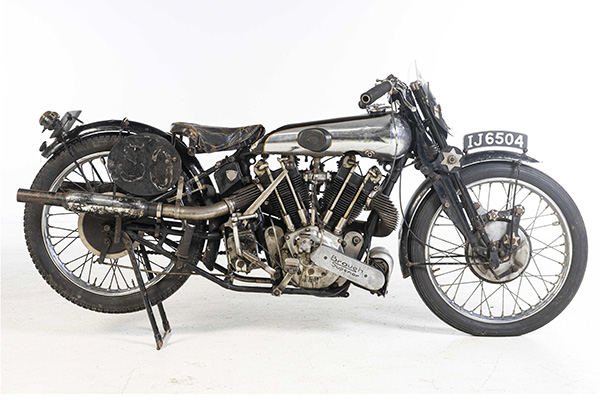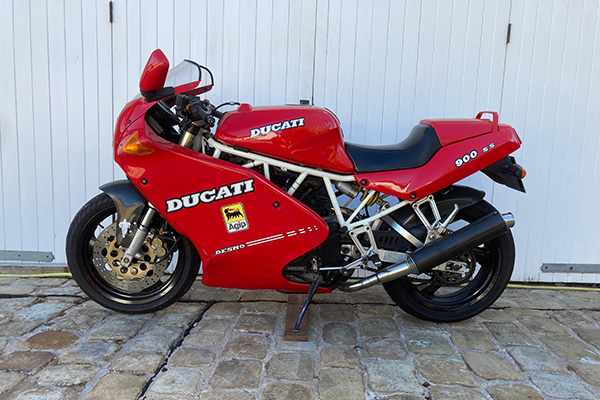3 April 2025
The Bonhams Cars Motorcycles auction at The International Classic Motorcycle Show at Stafford Showground on April 26-27, 2025 may have a long name and a lengthy introduction, but, in short, it could be one of the most important sales for years. Iain Macauley, automotive journalist, explores the topic further.
It's raised the question amongst sellers and collectors alike: has the classic motorcycle market completed its valuation "correction" after the pandemic-provoked values peak, and post-Covid trough?

1961 BSA DBD34 Gold Star 500cc - estimated £10,000-£15,000
For a buyer, depending upon your age and motorcycling background, you could be either baffled, bemused or pleasantly surprised by the cost of classics in 2025. Meanwhile, sellers have been exasperated at unexpectedly low values - and sometimes big losses, especially on pandemic buys.
There's probably a formula or algorithm determining value, but it's likely to be a permutation of your age, the age of the bike involved in a buying or selling deal, what sort of part it played in your life - whether as something you owned or aspired to - plus its condition, and, crucially, how much you want it or want to get rid of it, and the reasons for wanting to own, or wanting to move on regardless of losses, all play a part.

1973 Kawasaki Z1 - estimated £13,000-£18,000
In other words: how firm or flexible is the market right now, and how much do you want it or want to get rid of it and either make somebody's day - or by niggled by paying too much, or accepting too little?
The general rule of thumb is that nostalgia buys are ruled by your formative motorcycling years, and either buying now what you couldn't afford then, or buying again what you owned in your teens or early 20s.
Most current nostalgia-driven classic bike owners or wanters are in their 50s or 60s. So that means bikes from the '80s, '90s or '00s should be at a peak of interest - if not value.
But there are other considerations: you may be older, taking you into '60s or '70s bikes. Original 1960s and '70s British bikes are rare for two reasons: firstly, many simply fell apart, but, secondly, the advent of Japanese bikes. They were advanced compared to British bikes, but they're rare for slightly different reasons: they were cheap, and so considered disposable when the European climate got to grips with early Japanese metalwork.
Stylish Italian bikes also suffered from rot, dodgy electrics and, in the UK, our damp and dismal weather.
But then there's also the simple fact that many of those bikers who aspired to pre-war machines are, frankly, in many cases past the stage in life at which they want to ride or buy again, and prefer their nostalgia pangs to be satisfied by either looking at somebody else's older machine, or simply hanging on to one they may have owned for decades.

1927 Brough Superior - estimated £300,000-£350,000
There are, of course, '20s, '30s, '40s and '50s rarities such as Broughs and Vincents which can attract six-figure sums, but they're up there with must-have high-end collectable art, if not in price, certainly passion.
So what can we expect from the Bonhams Stafford show auction?
Well, first of all, mouthwatering machinery for every generation of classic bike enthusiast.
The question is whether to restore, ride or simply store to sit and look at or hope for an investment benefit.
Let's deal with investment first. The truth is not many machines will yield huge returns in the same way early-mid 20th century "superbikes" such as Broughs and Vincents or rediscovered '70s and '80s Japanese Hondas, Yamahas, Suzukis and Kawasakis did.

1937 Vincent Rapide - estimated £180,000-£240,000
Broughs and Vincents are more about retention of value, while Japanese bikes have, if anything, fallen away in terms of prices - for now. That's probably more about the state of the economy and disposable income levels.
British bike enthusiasts and collectors have probably traded or possess everything that may have been investible, with a few "missing" icons known to exist, but whereabouts unknown, while experts and auctioneers, sworn to secrecy, know where others are stashed. The surrounding mystique means a premium price.
Which takes us to ride or restore.
If restoring, then research the hell out of the machine you have your eye on. Bear in mind that some parts are simply or seemingly no longer available. It took me five years to find two key parts for an early 1970s Yamaha I rode while restoring. One was sitting on a shelf in some kind of bike breakers in Singapore and cost five times as much to ship as the price of the part - the seller had no idea of its rarity.

A ride and restore investment, perhaps. 1993 Ducati 900SS, 32,900 kms. Estimated £2,000-£3,000.
The other part was in the USA. I bit the bullet and paid full whack, but at least shipping came free when my Los Angeles-based son took delivery and I collected it while on holiday there. But it made my bike complete, and with virtually all-original parts. It probably also added that last bit of value and desirability.
But then there's the "just ride it" argument. Auctioneers, owners and owners' clubs alike will say pretty-well the same thing: if it's got "push around" mileage on it, then store it. It'll likely have some investment benefit value ... one day. If it's got a few hundred miles on it, then a few dry-weather summer weekend rides will do it good.
But if it's been used - then use it. Frequently. That turns your classic into an experience rather than just a possession.
But then, of course, all this completely falls apart if, as many have done: you go to Stafford to bid on one specific machine, but, come the auction itself, you buy something completely different.

COMMENT